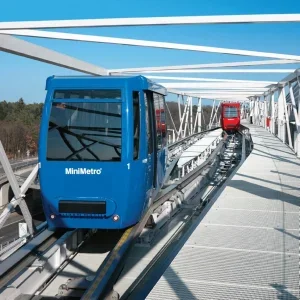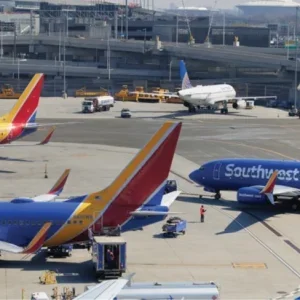Future Airport: Beyond cost savings, what is the rationale for making Hong Kong International Airport more energy efficient?
Airport Authority Hong Kong: Environmental protection is a core value of Hong Kong International Airport (HKIA). Airport Authority Hong Kong (AAHK) is committed to using the best environmental management practices to minimise HKIA’s environmental footprint.
The underlying objectives go beyond cost reduction and resource efficiency to gaining support from the community: the public’s acceptance and approval of the airport’s operation and development. As the airport operator, AAHK has a clear responsibility to take the lead. It is therefore important not only to demonstrate that AAHK’s commitment to environmental management leads to continuous improvement in environmental performance, but also to proactively engage with stakeholders and the wider public to build trust and credibility.
How does AAHK work with other stakeholders operating at the airport, such as airlines, contractors and border security, to achieve more energy-efficient practices?
AAHK works closely with its business partners at HKIA, the airport community and the wider aviation sector to address environmental issues, particularly where collaboration can accelerate the rate of footprint reduction.
AAHK completed the first carbon audit of its own buildings and facilities in 2008 and became one of the Environmental Protection Department’s ‘carbon audit green partners’.
AAHK extended the audit airport-wide in conjunction with its business partners in 2009. AAHK and about 40 business partners pledged to reduce carbon emissions by 25% per workload unit by 2015 from the 2008 emission levels.
HKIA is the first airport in the world to commit to an airport-wide carbon-reduction target. It is also the first to voluntarily make a sector-wide carbon-intensity-reduction pledge in Hong Kong. To facilitate the reduction scheme, AAHK developed a proprietary online carbon audit system in 2011 that provides a carbon monitoring and reporting platform for AAHK and its business partners. Its 46 business partners worked with AAHK to reduce the carbon footprint under the HKIA carbon-reduction programme.
AAHK has engaged a consultant to develop new five and 20-year targets, and advise on associated reduction strategies. The study is expected to be completed this year.
HKIA’s efforts in carbon reduction have been recognised internationally. In December 2012, HKIA achieved the optimisation level under the Airports Council International-Airport Carbon Accreditation (ACI-ACA) programme. This is the second-highest level of accreditation, and HKIA is the first airport in the Asia-Pacific region to achieve this standard.
How has this cooperation manifested itself as part of the airport’s carbon-reduction audits?
As of 2014, the airport-wide carbon intensity was reduced by approximately 22.4% compared with the baseline level in 2008. The carbon-reduction performance for 2015 was under evaluation and will be completed in the very near future.
What sustainability features were considered at the design stage for airport buildings – particularly the new Midfield Concourse (MFC) – rather than being retrofitted?
The MFC was built with HKIA’s commitment to high environmental standards. MFC houses cutting-edge technology according to an environmentally friendly design, with more than 35 green features, including low-energy lighting systems, high-performance glazing panels, solar shading and north-facing skylights to maximise the use of natural light and regulate indoor temperature.
It also boasts features such as planters, green walls and rooftop solar panels. MFC adopts the principles of reusing and recycling in its daily operations, and aspires to be one of the first buildings in Hong Kong to be certified with the BEAM Plus Gold Standard.
What savings has the LED replacement programme at HKIA produced so far? How were the previously used incandescent lights disposed of?
The LED replacement programme replaced 100,000 traditional lights with LEDs in the terminal buildings over six years. The actual saving from the project is 18.2 million kilowatt-hours a year, equivalent to 11,500t of carbon, which is 20% more than the estimated savings of 15.0 million kilowatt-hours at the start of the project.
The previously used lights were disposed of according to the Environmental Protection Department’s statutory requirements.
How was the HKIA’s food-waste-management programme extended beyond the airport to other businesses in the area?
AAHK has been collecting food waste for recycling since 2003. With the support and participation of restaurants at HKIA and business partners, the scope of collection was expanded to cover 17 airport business partners, including hotels and airline caterers.
To encourage catering outlets to collect food waste properly, AAHK held briefings for tenants and provided guidelines on food-waste classification. Inspections are also carried out to remind tenants and their staff to use the recycling bags and bins correctly. AAHK will continue to communicate with tenants and organisations to encourage waste recycling at HKIA. In 2014/15, 1,150t of food waste was converted into fishmeal as a result of this initiative.
In 2014, AAHK ran a pilot programme with Swire Properties and Link REIT to collect food waste in Tung Chung. The programme was completed successfully in 2015 and AAHK is exploring ways to extend food-waste recycling to other organisations and facilities in Tung Chung.
Apart from food waste, AAHK has also partnered with Food Angel, a local NGO, since August 2013 to collect surplus food from restaurants and caterers at HKIA. The collected surplus food was transformed into hot-meal boxes for distribution to the underprivileged. In 2014/15, Food Angel collected 17.5t of surplus food and made it into over 20,000 meal boxes.
How successful has the adoption of biodiesel been for vehicles operating at the airport? How much of an impact has that made to the airport’s emissions overall?
AAHK has facilitated recycling of waste cooking oil from airport restaurants since March 2008. In 2014/15, around 30,000L of waste oil were collected and recycled into biodiesel, helping to reduce greenhouse gas emissions, lower harmful air particle levels and conserve fossil fuels. In 2008, AAHK joined hands with the University of Hong Kong to pilot two trials on five diesel vehicles. Results verified that B5 biodiesel significantly reduced dark-smoke emissions by up to 50% without affecting the performance of the operation of the vehicles. At the moment, biodiesel is used in our fleet of 48 passenger buses.
Have other international hub airports followed the example set by HKIA with respect to environmental responsibility? Have they sought advice from AAHK?
In May 2012, HKIA pledged to become the world’s greenest. Many other airports have developed excellent environmental management programmes from which HKIA has adopted measures to support its own environmental performance, and HKIA is in regular contact with airports worldwide to share environmental practices, helping the whole airport sector to reduce its environmental footprint. The principal mechanism for exchanging best practice is ACI’s World Environment Standing Committee and its five regional committees.
HKIA currently holds the chair of the ACI Asia-Pacific Regional Environment Committee, through which it has supported the development of an environmental survey of member airports in the region. It has also led an initiative to develop common guidelines for the handling of aircraft-cabin waste. The guidelines will be jointly published by IATA and ACI.
What other plans does the airport authority have to improve its sustainability in future?
AAHK will continue to work to improve its future sustainability. AAHK is currently preparing a new airport-wide carbon-reduction target, which will be rolled out later in 2016.
In addition, AAHK will develop the HKIA biodiversity conservation and action plan, and will upgrade its environmental management system in line with the ISO 14001: 2015 standard – it is preparing for certification in 2017. Finally, AAHK will also complete a comprehensive waste-management study this year with the aim to recycle half of all the waste generated at HKIA by 2021.






